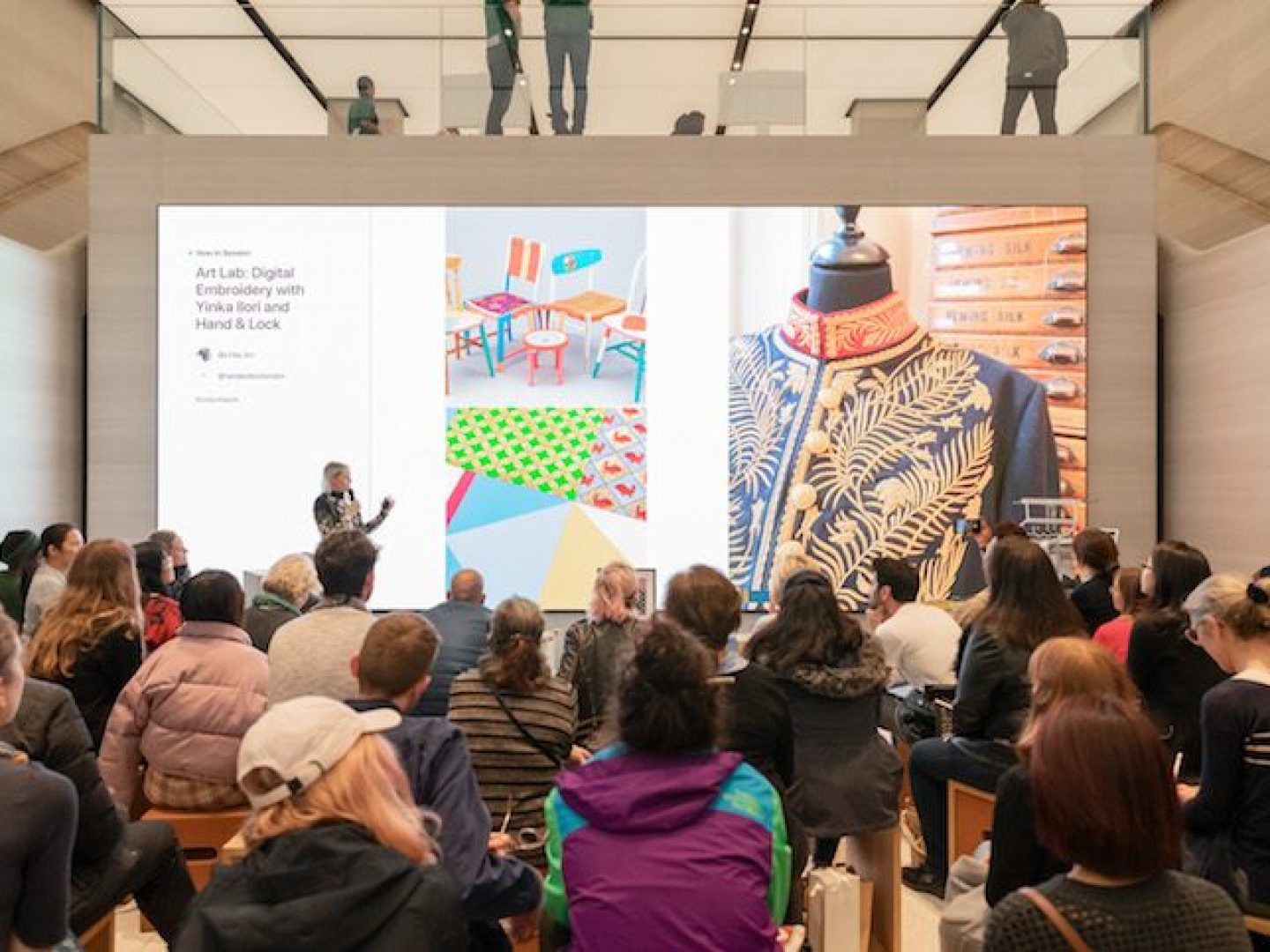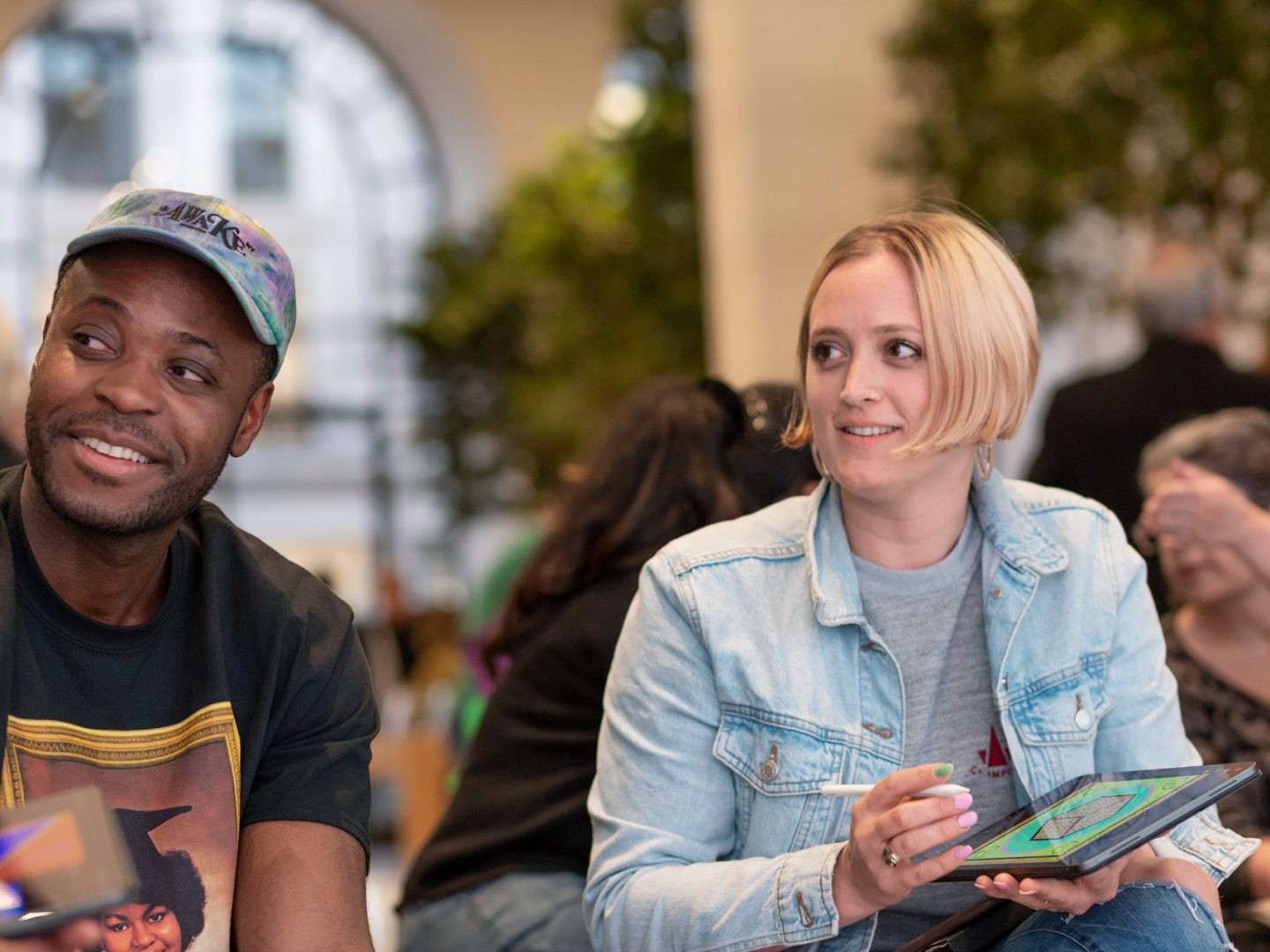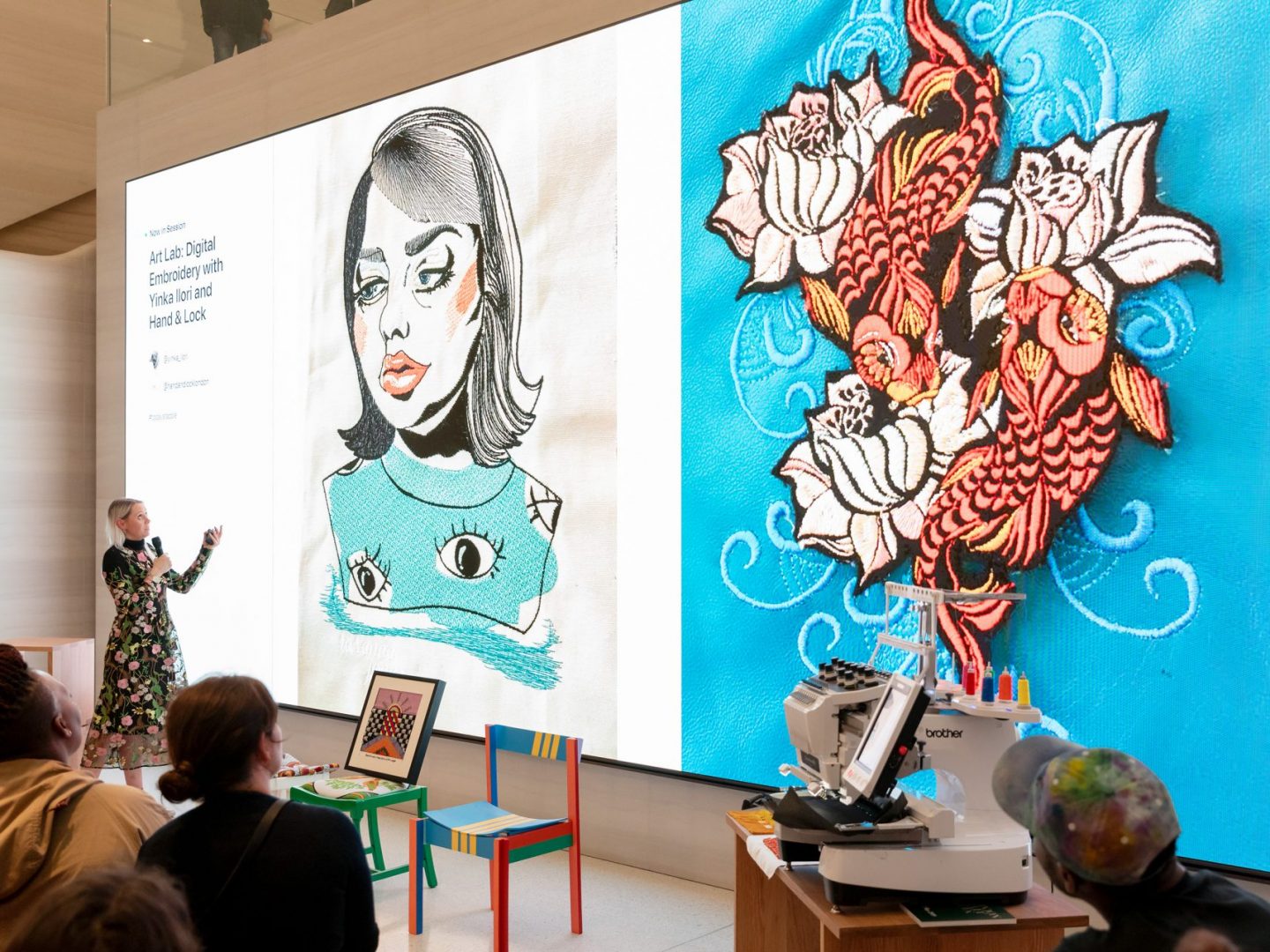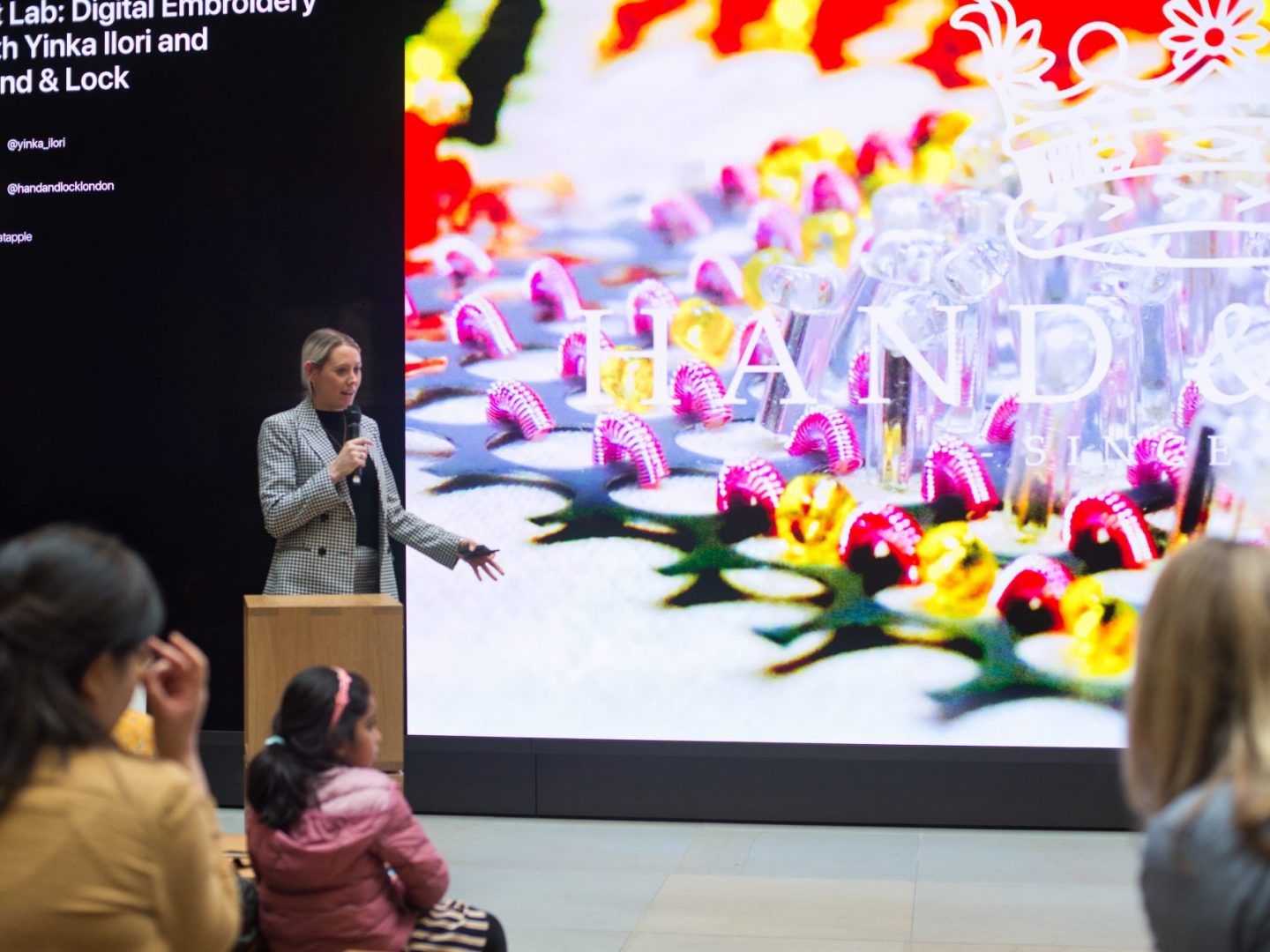

In the Spring of 2019 London Craft Week organised a collaboration between Californian tech giant Apple, artist and designer Yinka Ilori and embroidery house Hand & Lock.
The brief was to work together to produce a work of art that expressed our joint identities. Then we would go on to lead an in-store #TodayAtApple workshop, where participants could follow suit.
Ilori, who is a successful London based artist with Nigerian heritage started the process by producing a two dimensional artwork using the Procreate app. Through multiple meetings Hand & Lock sought to infuse his idea with the essence of traditional hand embroidery.
Hand & Lock’s identity would ultimately be represented through the use of goldwork embroidery, the company’s historic speciality.
With all of H&L’s design collaborations a great deal of thought and planning is undertaken before anyone threads a needle. Ilori’s design was full of colour inspired by the Dutch wax prints that had been introduced to West Africa by the Dutch traders in the 1880s. We researched the history of these prints and how they are frequently paired with chunky beaded jewellery. The jewellery became a starting point for how our embroidery designers approached the project. Mood boards were developed and a materials were found to match Ilori’s bold colours.
Eager to make sure Hand & Lock’s ancient crafts and modern techniques were represented we decided to incorporate both hand and digital machine embroidery into the final piece.
The machine embroidery was designed as a series of tone on tone repeat patterns. In digital embroidery terms we call this a ‘fill’ – a decorative design we can use to fill a specific area of fabric. This can be designed on specialist embroidery software with a few clicks of the mouse. Given the fill is digital, we liaised with the team at Apple to make sure the same textures could be made available within the Procreate app. This was a vital tool for the participants who would ultimately join us in the planned Apple workshops. Integrating a machine-like ‘fill’ into the iPad app meant someone designing embroidery on Procreate could see how their design might turn out.




When the time came to begin embroidering we started by digitally printing Ilori’s design onto a cotton drill. A good quality, stable fabric was essential for the amount of dense and heavy embroidery we had planned. The benefit of choosing digital printing meant Ilori’s colours would clearly show wherever there were spaces in the embroidery. Our tone on tone ‘fills’ were one such area and these were the first stage of the embroidery process. Once the digitally designed tone on tone fills were stitched out, the cotton drill was framed up ready for our hand embroiderer to start work.
Inspired by Nigerean chunky bead jewellery we decided to create dense loops of 3D beading. These loops would rise up from the surface of the design in a small ark before returning to the material. Each ark was loaded with small beads mirroring the shape and materiality of the Nigerian beaded necklaces, but realised on a miniature scale. These 3D beaded loops were grouped together to form squares in white and black. The overall area becoming like a monochromatic chess board. Between these areas of the design Illori had created a brightly coloured, bold graphic abstract. This was where our embroiderers applied a contemporary take on traditional goldwork. Typically goldwork is metallic in appearance, often gold. However, here we used coloured bullions raised over a low relief and edged in a contrasting black purl pearl. The final design literally raised Ilori’s colours off the fabric and fused his design with a modern take on Hand & Lock’s most traditional technique. More goldwork was added above the abstracted square along with some small flower beads that appealed to Illori during a design meeting. Part of every design process has to be a flexibility and willingness to improvise.
When a material, bead or colour excites, it’s always a good idea to try and work it into the final piece. Embroidery of this nature relies on bold textures and should be tactile, exciting to the eye and fun. The same sense of playfulness comes through in the application of the teardrop emerald stones applied over the digital fills at the bottom on the piece.
The final embroidery was completed in the studio, carefully framed and labelled ready for the series of talks and workshops.
Apple planned two talks in their Regent Street and Covent Garden stores. These included H&L director Jessica Pile speaking alongside Yinka Illori about the collaboration. These sessions were followed by workshops where attendees could express their own identities using the Procreate software complete with the embroidery fills. The workshops included guidance from the H&L team, the artist and technical specialists from Apple. Embroidery samples were on show and a live digital machine was on site to demonstrate the process of stitching out fills. Designs, made by participants at the workshops will be made into embroideries by H&L, to be displayed in London Apple Stores and as part of the Bangkok Craft Week in 2020.
In addition to the practical workshops, a talk took place on the subject of ‘Digital Craft’ at the London Design Museum where specialists, including Pile and Ilori, discussed whether digital creative skills could be classified as crafts. The talks concluded with a panel discussion where many issues were raised. Questions such as whether a computer game developer is a craftsman?
Whether an animator’s animation could be considered craft? Or if a biologist’s process, making new fabric dyes, is arguably craftsmanship? Craft was considered in a contemporary context where the things we make aren’t always physically tangible goods, but still require exceptional skills.
The collaboration helped us better understand the value of our own practice and it granted us an opportunity to share our story and hear the stories of others. Most importantly it started a conversation about the future of craftsmanship. Preserving the skills of the past is vital, but recognising the skills of today that may one day become the crafts of tomorrow is also essential. H&L, Yinka Ilori, Apple and London Craft Week combined forces to ignite the debate. But where it goes from here, nobody knows.
London Craft Week is an annual celebration of craftsmanship and takes place in May each year.
Visit www.londoncraftweek.com for more information.
